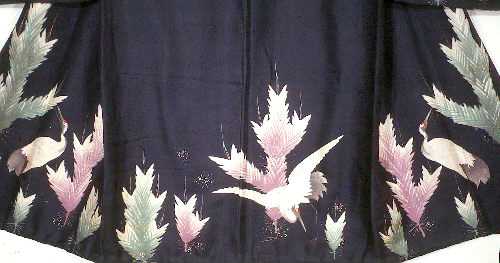Description
A Japanese Kimono mirrors the historical development of the country, and reflects the very elegance and style of its culture. The traditional “T” shape is instantly recognizable and represents a unique contribution to clothing construction. It became a means of expression for centuries of Japanese artists and artisans, becoming as much an original work of fine art as a practical garment. The Kimono became an official part of the family’s wealth, part of the daughter’s dowry and a highly prized heirloom that was treasured for generations. It is considered the National Japanese Costume.
This is a very fine, and unusual, small woman’s very old hand woven Silk Kimono. The design has been created through the “Rice Paste Resist” or “Tsutsugaki” technique of painting. This method required an enormous amount of artistic skill, as each color had to be applied separately, while all the others were painted out in the rice paste. Each time a new color was added; the rice paste had to be removed by soaking it out over and over again in the local river water, and then reapplied. This is an extraordinarily difficult, time consuming, and labor-intensive artistic process that often took months to accomplish. The design is an over sized vision of Mandarin Crane among the Pines. This is one of the most popular of all Japanese designs, but to apply it completely, around the bottom of the Kimono, is not traditional…the artist has achieved an incredible pattern balance. The Crane (“Tsuru”) is considered a harbinger of good fortune and symbolic of long life. Legend has it that it takes the Crane 1000 years to fly to the sun; and, as such, it is a most auspicious sign. The glorious lavender and light green stylized Pine Trees (“Matsu”) are also representative of longevity.
This is a formal Kimono, as it sports 5 of the Family Crest, or “Mon.” The Crest is that of the Wisteria (“Fuji”), one of the most valued of all design motifs. All the artistic skills applied to the creation of this Kimono required tremendous talent, and laborious and time-consuming skill. Add to the wonderful hand weaving, hand dying and hand painting of this charming Kimono, the accumulation of the small pure gold highlights that appear to have been pounded into the fabric rather than painted onto it; and, it becomes obvious that this colorful and exquisitely decorated Formal Silk Kimono obviously belonged to a woman of high social standing and great wealth, and would have been a valued family heirloom.
A Certificate of Authenticity is included.
TTAC will personally pack and ship via UPS at company expense within the continental U.S.








